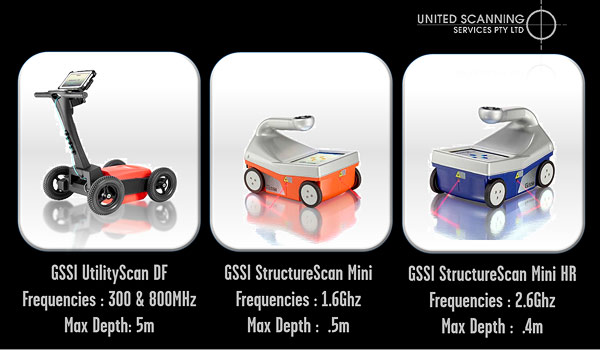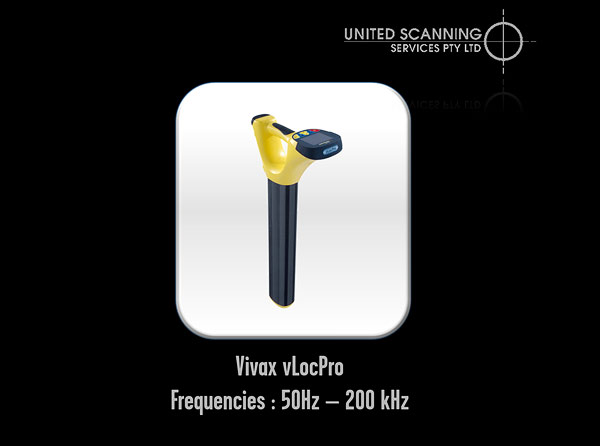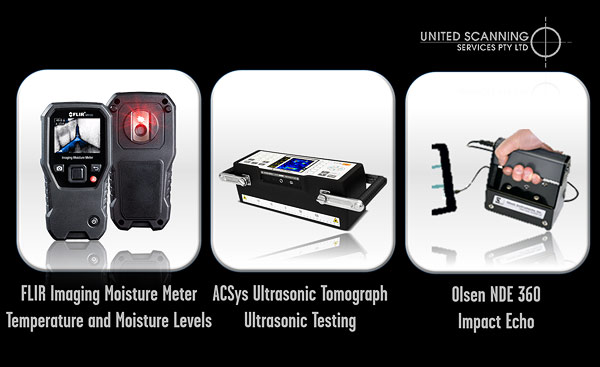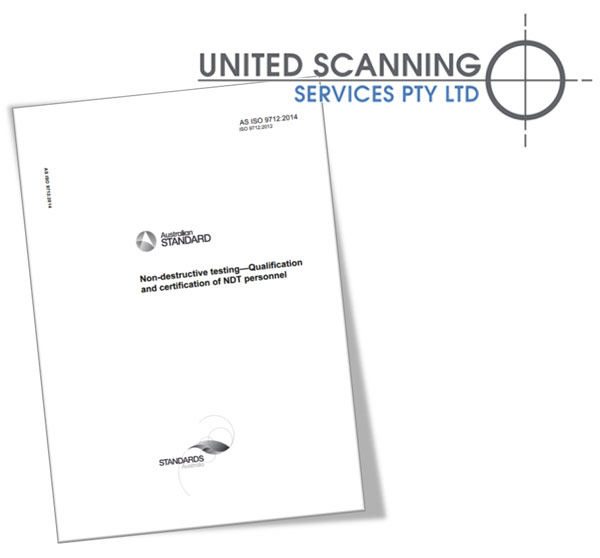Non-Destructive Testing
United Scanning are often approached by clients who need to know something about their services or their concrete but are concerned about the damage that may need to be done to discover what they need know. Does the stormwater run under the forecourt? Have I got sufficient reinforcement to place additional load on this slab? Has the poured concrete fill penetrated to the bottom of the wall? Common wisdom would suggest that to answer these questions will require a least digging up part of the forecourt, uncovering some of the reinforcement or drilling holes at the bottom of the wall.
Non-Destructive testing (or NDT) describes the analysis techniques used to answer questions like these ones without causing damage. Every year, United Scanning perform a wide variety of investigations for clients into material properties and dimensions (how hard and deep is my slab?), service locations (where does the power run) and construction quality (are there defects in this pour?) using techniques and technology that is completely non-invasive and leaves the thing being investigated completely intact.
Because Non-Destructive Testing can leave the objects, structures and materials being tested completely unharmed, it saves United Scanning’s clients both time and money. The information they need to proceed with their project can be provided without slowing down the project or impairing the quality of what has already been done.
Ground Penetrating Radar is an example of a Non-Destructive Testing technology that United Scanning regularly apply. Using our high resolution 2D and 3D radar scanners, United Scanning can provide information about the depth of concrete, the position and size of reinforcement inside the concrete, the amount of cover over the reinforcement, the presence and position of voids, honeycombing, cold joints and other defects in concrete, the path of PT cables, the depth of the bedrock or tree roots and many other important answers to our client’s questions, all without any invasive investigation or damage.
In order to obtain this information, a United Scanning technician may run one of our radar units over the surface or structure about which our client needs information. Each of the radar devices we use is specialised to its task.
A trolley mounted UtilityScan ground penetrating radar unit, producing radar at two frequencies (300 and 800 MHz) is used to collect information in soil, sand and clay or under a layer of concrete.
A StructureScan Mini handheld scanner with soft rubber wheels, producing radar at 1.6Ghz is used to discover slab depths and service locations inside concrete.
A different handheld scanner, the StructureScan Mini HR, again with soft, non-damaging rubber wheels, producing radar at 2.6Ghz, is used when the size and 3D position of reinforcement, services and defects is the information required.

Figure 1: Ground Penetrating Radar devices
Each of the units is completely non-invasive and non-destructive, leaving no trace that they were even used, other than perhaps tyre tracks in sand.
United Scanning also provide clients with an Electro-Magnetism (EM) Detection service that is likewise, non-destructive and non-invasive. This technology utilises the creation a signal down an existing cable (either power of communications) which will then allow United Scanning’s technicians to follow the path of the cable based on the strength of the electro-magnetic wave produced by the signal travelling down the cable. In some cases, the cable is live and can be traced without even touching the cable.

Figure 2: An EM Detection wand
In other cases, the United Scanning technician will be required to find a termination point of the cable to begin with, often in a communications pit or point of power entry to a building or structure. Having confirmed that the cable is dead and safe to trace, the technician will then place a clamp on the cable that sends a detectable signal down the cable that the technician can use to trace the cables path with.
Other NDT technologies that United Scanning have applied to provide clients with insights without damage or loss include the use of thermal imaging and moisture measurement using high end thermal imaging cameras, ultrasonic concrete inspection using an ultrasonic tomographic imaging device, impact echo testing that analyses the echoes that return after a hard surface is tapped with a very small metal hammer, relative humidity testing to provide confidence during concrete curing and drying, not to mention good old fashioned visual inspection by the trained eye of one of our technicians.

Figure 3: Other Non-Destructive Testing devices
Non Destructive Testing is a very well-known discipline, so much so that the training and certification of Non Destructive Testing personnel is governed by standards both globally (ISO 9712: Non-destructive testing — Qualification and certification of NDT personnel (2012)) and nationally (AS ISO 9712:2014 Non-destructive testing—Qualification and certification of NDT personnel).

Figure 4: An Australian Standard for Non-Destructive Testing
At United Scanning, all laboratory testing, whether non-destructive or destructive, is conducted at a laboratory that is accredited by NATA (the National Association of Testing Authorities). NATA are a signatory and a committee member for the construction of the Australia Standard and laboratories accredited by them are expert in Non Destructive Testing and Analysis.
Very often United Scanning client’s call us even though there are other ways to answer the question than using NDT methods. United Scanning have the skills and technology to answer those questions without stopping the project, or worse, reversing its progress, without causing damage or destroying what was being questioned, without causing harm that may be more expensive than the answer seems worth. NDT is a tried, tested, standardised and well understood set of analysis techniques and United Scanning’s clients trust us to provide them with answers to their questions about what’s in their concrete and where their services lie.
